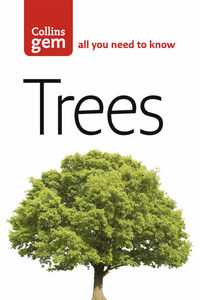Cover
Title Page
Introduction
Maidenhair Tree (Ginkgoaceae)
Yews (Taxaceae)
Monkey Puzzle (Araucariaceae)
Cypresses (Cupressaceae)
Junipers (Cupressaceae)
Cedars (Thuja; Cupressaceae)
Redwood and allies (Taxodiaceae)
Firs (Pinaceae)
Hemlocks (Pinaceae)
Spruces (Pinaceae)
Larches (Pinaceae)
Cedars (Cedrus; Pinaceae)
Pines (Pinaceae)
Willows (Salicaceae)
Poplars (Salicaceae)
Walnuts (Juglandaceae)
Birches and Alders (Betulaceae)
Hornbeams and Hazel (Betulaceae)
Beech and Sweet Chestnut (Fagaceae)
Oaks (Fagaceae)
Elms and allies (Ulmaceae)
Mulberries and Fig (Moraceae)
Tulip-tree and Magnolias (Magnoliaceae)
Plane (Platanaceae)
Pears and apples (Rosaceae)
Rowan, service-trees, whitebeams (Rosaceae)
Mespil and Medlar (Rosaceae)
Hawthorns (Rosaceae)
Cherries, plums and allies (Prunus)
Laburnum, Acacia and allies (Leguminosae)
Citrus trees (Rutaceae)
Tree of Heaven (Simaroubaceae)
Maples and Sycamore (Aceraceae)
Horse Chestnuts (Hippocastanaceae)
Holly (Aquifoliaceae)
Spindle-tree, Box and buckthorns (Celastraceae, Buxaceae, Rhamnaceae)
Limes (Tiliaceae)
Gums (Myrtaceae)
Cornelian Cherry (Cornaceae)
Rhododendron and Strawberry Tree (Ericaceae)
Ashes and Olive (Oleaceae)
Foxglove Tree (Scrophulariaceae)
Indian Bean Tree (Bignoniaceae)
Elders (Caprifoliaceae)
Palms (Palmaceae)
Searchable Terms
Copyright
About the Publisher
TREES AND HOW THEY GROW
‘Tree’ is one of those useful words that have no precise definition, yet are immediately understood. Most botanists envisage a plant more than 3–4m high, with a single woody stem that persists for many years, and a branched crown. The extremes are clear-cut–a well-grown beech or pine is indubitably a tree–but there is a grey area between ‘trees’ and ‘shrubs’. Apple trees for example frequently branch at ground level, but can still produce a crown 8–10m high, whereas blackthorn is almost always a shrub, forming a dense tangled mass with no stems, but if drawn up by the shade cast by surrounding trees, it produces a single trunk and a respectable small tree.
The word tree, therefore, best describes a form of growth rather than an individual species, so this book includes species such as osier, blackthorn and alder buckthorn that are normally shrubs, but which do grow into small trees occasionally.
How, then, does a plant turn into a tree? First it must lay down wood: this is produced when xylem, the tissue in plant stems which transports water from roots to leaves, becomes thick-walled and toughened. Secondly, the stem must stay alive for many seasons, which means that the buds must be borne on the tip of the shoot and not at ground level, as in tall herbaceous plants, in order to survive cold winters or other extreme conditions.
Of course the main advantage of being a tree is to be tall and so to get more light than surrounding plants. But basic engineering constraints require the strengthening of the base of the stem that provides support. This is brought about partly by the growth of the root system, anchoring the whole plant, and partly by the gradual thickening of the stem. Each year the whole stem from top to bottom puts on a new outer layer, so that the trunk becomes gradually thicker towards the base, and the resultant shape is in fact almost perfect from an engineer’s standpoint. If you measure the height and girth of several specimens of a single species of tree you will find that there is a very close relationship maintained between them, almost throughout its life.
This continuous outward growth means that the conducting tissues are always on the edge of a tree trunk (which is why you can kill a tree by ring-barking it), and the older tissues in the centre of the trunk serve as tough supporting tissues, the channels that once transported water to the leaves eventually being filled in. In temperate regions, with a cold winter during which growth ceases, this form of growth produces annual rings, which can be used to date a felled tree.
SOME PROBLEMS OF BEING A TREE
Most trees, except when planted for ornament, grow in woods and not as isolated specimens. Those magnificent trees that adorn the parks of stately homes are rather exceptional in the tree world. Few of their relations will get the chance to expand in all directions without coming up against neighbours. So, while the parkland tree grows up and out, its woodland counterpart is drawn always upward, for a tree that failed to do so would soon be overshadowed by those around it.
The shapes of trees, then, reflect their way of life. But living in woods imposes other constraints, for survival and success for a species involves shedding good seed that grows into new trees. When a seed germinates on the floor of a wood, it has little chance of growing steadily to the canopy 20, 30, perhaps even 50 metres above it. There is too little light to allow that. Instead the seedling must wait for a tree to fall or die, letting in light, and so allowing the race for the tree-tops to begin. In a beechwood you will see many young trees a few centimetres high, but very few more than that, except where a tree has fallen some years before. There, the gap will be filled with a mass of young trees, often ash or sycamore, growing into the space. Underneath them, growing more slowly, but more tolerant of the shade they cast, will be the young beech trees, one of which will eventually become the new occupant of that particular patch of sunlight.








